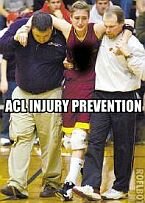Knee - Patellar Tracking Disorder
You may have noticed that there are times when you bend your knee that things dont feel like they are moving correctly. You may experience pain or hear clicking noises. There are even times when it looks like your patella (knee cap) isnt exactly where it should be. This is an injury known as patellar tracking disorder. Runners and cyclists are the athletes that are most often affected by this condition because of the repetitive motions that occur when exercising.Patellar tracking disorder can occur from a multitude of reasons. Most commonly the muscles of the thigh are injured, tight or weak. Specifically the muscle that is most often the cause of patellar tracking issues is one of the quadriceps muscles called the vastus medialis obliquis (VMO). The main action of this muscle is to pull the patella medially (toward the middle of the body). With an injury to this muscle the patella will no longer slide along the groove in the end of the femur (thigh bone). Once the patella has left the groove on the femur, the cartilage on the back of the patella can become damaged. This can lead to another condition known as chondromalacia patella. With an injury to the hip flexors, especially the rectus femoris (the largest of the four quadriceps muscles which also extends the knee) there can be patellar tracking issues as well. Ligament instability in the knee can also cause patellar tracking problems.
The most common symptoms of patellar tracking disorder are pain when walking down stairs, sitting for long periods of time, standing after sitting, squatting improperly and running. There may be clicking, popping, grinding or catching when first bending or extending your knee. Some patients also describe feeling like their knee will buckle and will no longer support weight on it. With a prolonged injury there may also be mild inflammation around the knee. Often patients will live with the pain for long periods of time before they seek any type of treatment. If patients knew how easy this condition was to treat they would be more likely to seek treatment sooner.
Treatment for patellar tracking disorder usually involves rest, ice, and anti-inflammatories (preferably natural anti-inflammatories like bromelain, ginger, turmeric, and boswellia). These steps can relieve the pain, but the cause needs to be addressed to complete treatment. If the patient has an injury to any of the aforementioned muscles (VMO, recturs femoris, hip flexors), soft tissue work needs to be performed to break up adhesions and scar tissue within the muscle. Soft tissue treatments like Active Release Techniques® (ART) and Graston Technique, which we perform at Capital Sports Injury Center, work well with this injury. Once the adhesions have been removed, strengthening of the muscles must be performed. Start with something simple like a straight leg raise where the knee is in full extension. You can also work on doing body weight squats with proper technique. Squatting requires the all the muscles of the thighs and hips to work together and allows the VMO to keep the patella tracking properly. Deadlifts and lunges are also great exercises to strengthen your lower body. Finally, core strengthening must always be part of a rehabilitation and training routine.
As you can see patellar tracking has many causes but is actually a fairly easy condition to treat. Once the many cause of tracking has been discovered patients usually respond very quickly. At Capital Sports Injury Center we offer ART, Graston and corrective exercises as are main forms of treatment. If you are having knee pain that sounds like it could be patellar tracking disorder feel free to contact us at painfree123@gmail.com or at 301-622-9000. As always we will be more than happy to help you with any questions you have. Remember to train smarter and not just harder!
|
The Ultimate Nutritional Lie Detector Test LEARN MORE 
|
Kettlebell Rehab

Click Here
To See How Kettlebells will transform your body!
Vortex Rehab

Click Here
To See How This
Revolutionary Machine
Can Help You!
Partner / Support

Loans up to 3 months - fast cash advances for up to 90 days and up to $5,000!


















